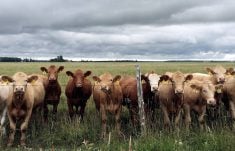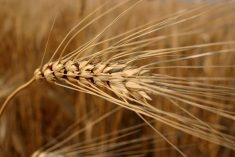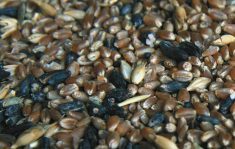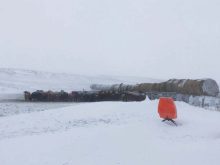Ergot is an issue for cattle feeders this year, and even the best testing may miss it.
Dr. Barry Blakely, a professor with the University of Saskatchewan’s veterinary biomedical department, says the good news is more feed companies are rigorously testing for it. The bad news is even the best testing could miss it because the nature of the infection means it will be unevenly distributed in the infected crops.
The problem is widespread and in particular feed pellets seem to be a factor in ergot poisoning cases.
Read Also

Seeding Indigenous agricultural prosperity
National Circle for Indigenous Agriculture and Food says Indigenous agricultural success needs strong relationships.
Blakely said that ergot is impossible to detect in pellet feed without laboratory analysis. A problem further compounded by the fact that feed pellets are made with screenings, which may be more likely to contain elevated levels of ergot. Broken, ergot-infected grain kernels are often mistaken for weed seeds, then end up in screenings.
“Two years ago, with 75 per cent of the diseased cattle that had ergot toxicity the history was that they were feeding them pellets that contained screenings,” said Blakely. “It’s high energy and good protein and it’s fairly cheap so a lot of guys want to feed that, but the problem is, all you need is a little bit in there and it really messes things up, so that is impacting on the feed companies because they can’t get rid of their cheap screenings it you want to call them that, the way they used to.”
There’s evidence the testing is working too, but that’s cold comfort to affected producers.
“The number of clinical disease cases has actually gone down,” Blakely said. “But the amount of contamination is still pretty high.”
The Manitoba Co-operator has confirmed a report at least one cattle producer in the province whose herd is showing symptoms of ergot toxicity after consuming contaminated feed pellets. However, the affected family declined to be interviewed for the story, citing ongoing negotiations with the feed manufacturer.
Blakely said it’s not surprising, given how widespread the problem is.
“We are seeing lots of it all over Manitoba, as well as Saskatchewan and Alberta, and we’re seeing it in all types of different grass-type crops, so it’s not just in rye… we do see it in wheat and barley and occasionally in oats, as well.”
Blakely said ergot is also appearing in native pastures, which is highly unusual.
“What happens with the native pastures, typically, is that the animals… graze it down to near the ground level so the crop or the grass never heads out, and that is where the ergot invades,” he said. “But this year, in many provinces like Manitoba, with a little more rainfall, they had nice lush crops that all headed out, so the chances of ergot infection were increased.”
And while successive wet years have created an ideal habitat for ergot, some management practices are also facilitating its spread.
“What’s happened is that when the ascospores are on the surface of the ground, or the ergot sclerotia and so forth, then the next year they germinate,” Blakely said. “But if you let them sit on the top of the soil they spread all over the place and invade.”
That means that no-till or low-till fields are more susceptible because soil microbes break down the ascospores when they are buried below the surface, rendering them unviable, he said. Uncut ditch grass can also provide habitat for the fungal disease.
Crop rotation plays a crucial role in keeping ergot under control, but Blakely noted it takes at least three years of non-susceptible crops to get rid of the fungus.
“And some guys are saying, ‘I can’t go that long without making any money and maybe sort of breaking even,’” he said. “But the crops that are making them money are the ones that contain ergot… and if your neighbour doesn’t rotate, you’re wasting your time, because it spreads.”
In cattle, ergot poisoning can lead to lower performance, reduced milk production, inability to lower body temperature, muscle spasms, reduced circulation and the sloughing off of tails, ears and hooves. New research has also found that some strains of ergot have greater toxicity than others, calling previous ergot guidelines into question.
Blakely said that ergot contamination guidelines developed in warmer climates don’t always fit with conditions on the Canadian Prairies either.
Brian Lemon, general manager of the Manitoba Beef Producers, said that while he hasn’t heard of any specific problems with feed in the province, ergot has become more of a concern in recent years.
“Be vigilant and recognize that ergot is a lot more prevalent in the grains on the Prairies these days,” he said. “As producers we need to be vigilant about making sure we work with feed companies that we know and that we’re comfortable working with.”
Lemon would like to see government regulations updated more regularly to accurately reflect new findings and current research.
“If you’re manufacturing feeds there are requirements under the Feeds Act… so there are standards, but one of the things we would ask is, is the standard appropriate given what we know about the research that is going on. These standards are 30, 40 or 50 years old,” he said. “One of the things we would like to see the government looking at more often is, are these standards all appropriate?”















